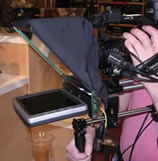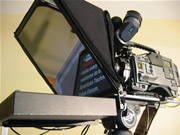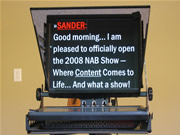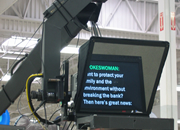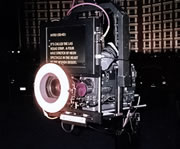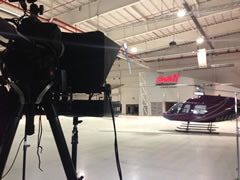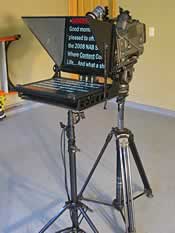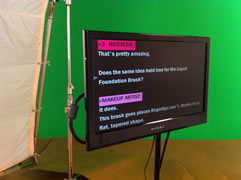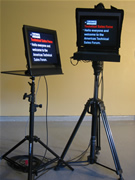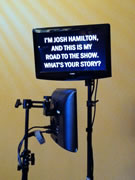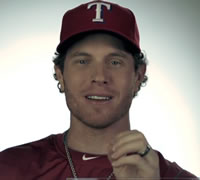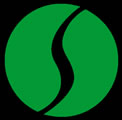FAQ’s Please click on the links below to toggle information on and off.)
Yes, we offer a 4-hour on-site rate, in order to meet our clients’ needs.
Our flat panel prompters range from 6 lbs to 20 lbs. Most of these are universal, working seamlessly with most professional cameras and tripods. However, some of our prompters will fit your specific needs better than others… and some rarer camera configurations will ONLY work with a very specific type of prompter. Bottom line: Give us any details you have regarding the camera and tripod, along with your shoot details, so we can supply the prompter best suited to your shoot. The more info you give us, the more tailored the solution.
No problem! We know which prompters will offer the optimal weight, size, and hood clearance for wide angle lenses to get the job done right.
Yes, our smallest thru-the-lens prompter adds only 6 pounds to your camera, but the cameraman will determine how long is too long to go hand-held.
Perhaps, but we haven’t run into them yet. Some of our prompters will work better than others when it comes to things like long lenses or large matte boxes. BUT, other attachments such as the Reflecmedia Light Ring will ONLY work with a specific type of prompter. Give us the details… we’ll give you a solution.
The glass will block ¼ to ½ stop.
Yes, but we must know ahead of time. Pre-planning needs to include power, prompter visibility in sunlight, and operator preparedness.
Yes, to scripts@speakeasyprompters.com. In fact, we prefer to get scripts ahead of time. We’ll reformat and prepare them for teleprompting, so that we can arrive on-site ready to go. Any preproduction script prep that takes over 30 minutes will incur a small hourly charge. But that’s time you won’t have to spend on shoot day, thereby offering a great return on investment! If you don’t have scripts available beforehand, bring them to the shoot on a USB flash drive in any of the formats listed below. But keep in mind, preparing a lengthy script on-site may eat into some of your shoot time.
Yes, we can, but let us know ahead of time so we can send our most optimal prompter for PowerPoint graphics. We can take both .ppt and .pptx.
- On-camera: The prompter is attached to the camera unit. On-camera doesn’t necessarily mean “thru-the-lens.”
It can be an on-camera “over the lens.”
- Over-the-lens: Usually on-camera, but above the camera lens, meaning your talent will not be looking directly into the camera.
As long as your talent remains a good distance away from the camera, you can assimilate a good eye-line.
- Thru-the-lens: This is the most common type of prompter and will always have the piece of reflective glass which displays your copy. While most “thru-the-lens” prompters are also “on-camera,” they don’t have to be used that way. By simply placing the prompter on an adjustable stand with the glass positioned in front of the lens, it becomes an “off-camera,” solving weight issues, but greatly limiting pans and tilts.
- Off-camera: The prompter is not attached to the camera unit. Typically, it’s a monitor on an adjustable stand placed on either side of the lens (interview style), or “over–the-shoulder” of talent (interaction style). But “off-camera” can also refer to a “thru-the-lens” prompter placed on a stand in front of the camera.
- Side Monitor: This will always be off-camera. It can be used interview style or interaction style -- for example, between a host and guests or between actors in a skit. Your script will dictate whether you need multiple side monitors or a combination of side monitors and thru-the-lens prompters.
- Stand-Alone: This prompter is always on its own adjustable stand. It can be placed “thru-the-lens” or elsewhere on your set.
We'll offer as much or as little help as you'd like. We can sit quietly in the background, or we can give your talent a quick “Prompter 101” course. Most importantly, we can assist them in editing their script to be conversational -- spoken in their own words, not read.
Our operators come from several different backgrounds – some with journalism, communications, and media degrees, some with TV news experience, and some with impressive executive assistant credentials.
Here’s what you can expect from SpeakEasy operators:
- Computer savvy
- Quick, proficient typists and transcriptionists
- Mastery of the equipment we provide
- Professional set-etiquette, including knowing when to speak up, when to stay quiet, and when to defer to the powers that be
- Personable, experienced and dependable
- Service-oriented, anticipating your needs and delivering above and beyond the expected!
Our operators have many years of “in the trenches” experience! So go ahead… SpeakEasy – we’ve got you covered.
